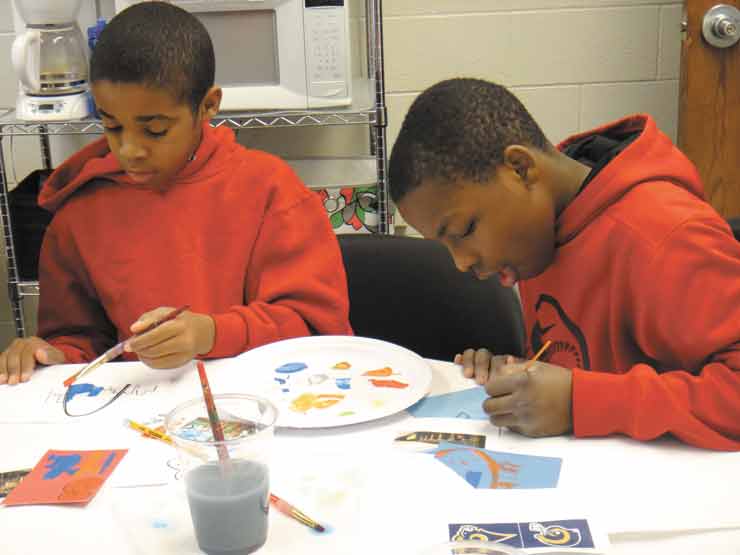
[craft alliance – 50 years]
At a free Saturday Craft Alliance program, families of various origins and zip codes sat around a table, engaged in a craft and talking about a TV show they all watch. Connections like this are part of the power of craft, says executive director Boo McLaughlin. “It was an unlikely mix of people and a diverse group working together in a creative capacity,” she adds.
Inspiring and instructing St. Louisans in creative endeavors has been Craft Alliance’s mission for 50 years. “It was started in 1964 by 15 artists committed to teaching craft techniques and exhibiting craft at a high level in the community,” McLaughlin says. Begun as a small co-op gallery on McPherson Avenue, in 1970 the organization moved to the Loop and switched focus to become a contemporary craft community center dedicated to making skills like pottery and weaving accessible to all. Since then, the organization has continually added to its scholarship funds, studio space and outreach programs.
In 2008, Craft Alliance opened another facility space in the Kranzberg Arts Center in Grand Center, including an exhibition site, artist-in-residence program and studios for wood-turning, clays, metals, fiber and graphic design. “Those artists can be there from three to 12 months,” McLaughlin says. “We’re bringing artists into the community to interact with students and offer a fresh perspective.”
To celebrate its 50th anniversary, Craft Alliance will host events throughout the year, including the biennial Teapot Exhibition, open until March 29, and the AR Trageous Gold Ball April 12 at the Palladium.

[community school – 100 years]
In 1914, a group of mothers wanted to send their children to a progressive school, so they built it. A century later, Community School remains dedicated to nourishing the intellectual, emotional, social, physical and moral growth in students from pre-kindergarten through sixth grade. “We see children not just as students, but as whole human beings,” says headmaster Matthew Gould. Students here achieve at high levels and get a liberal arts education in an elementary school environment.”
In 1914 and 1915, the school was known as Grace Church Kindergarten, then Hosmer Hall Kindergarten and Primary. It first called itself Community School in 1916, the same year it moved to a four-room building on DeMun Avenue. In 1931, the school purchased 16 acres on Lay Road, its current location. Since then, it has expanded to include a building for third through sixth graders, a fine arts wing and an early childhood wing.
“We’ve done all sorts of additions and enhancements to the facility and program, but the core mission of the school has remained unchanged,” Gould says.“The founding philosophy included 10 guiding principles, and it’s amazing how modern they are.” They include recognizing each child as an individual, freedom to develop differences, child-teacher cooperation and the importance of independent thinking.
Among the school’s graduates are prior Washington University chancellor William Danforth, pianist Peter Martin and other notables. During its centennial celebrations, alumni are invited to visit and interact with students. The school also will host a series of events the first weekend in April, and construction is underway on the new Centennial Arts Center.
[epworth children & family services – 150 years]
Kelly is a successful woman doing important work for a local nonprofit, but her life has had its share of challenges. “She started out in foster care, and ended up at Epworth when she was a teenager,” says Kevin Drollinger, CEO of Epworth Children & Family Services.
For the past 150 years, helping children and teens with troubled backgrounds become successful adults has been Epworth’s mission, Drollinger says. “Kids find strength by working with us, and they get into a position where they can make something of their lives.”
The organization was founded in 1864 as a mission agency of the United Methodist Church to care for Civil War orphans. “These kids were living on the East Coast and didn’t have anywhere to go, so they created orphan trains and sent them west,” Drollinger says. While healthier children quickly became adopted by farmers or families looking for an extra helping hand, the less healthy were often left behind. “Nobody wanted them, so these women created an orphanage in Warrenton to help them reach adulthood,” he adds.
Today, Epworth provides an array of services, including emergency shelter, residential treatment, foster care management and street outreach programs.“We don’t have a cookie-cutter program—it’s focused on individual needs,” Drollinger says.
As part of its 150th anniversary celebration, Epworth will honor Noemi and Michael Neidorff and Centene Corporation with the Pillar of Strength Award on Feb. 15 at The Ritz-Carlton.

[central institute for the deaf – 100 years]
At a CID summer enrichment program, Jessica and Allie engage in a lively conversation. There’s nothing extraordinary about two young girls gabbing, but this everyday interaction might not be possible without CID . “Those conversations are what we are all about,” says executive director Robin Feder.
Dr. Max Aaron Goldstein founded CID 100 years ago, after becoming frustrated with the lack of special education available for deaf children in St. Louis. “At the time, deafness was seen as an insurmountable disability, but Dr. Goldstein had a vision that if parents, doctors, scientists and teachers could work together, there would be tremendous possibilities,” Feder says.
The institute began as two rooms in Dr. Goldstein’s medical office and moved to a CID -specific school in 1916. In 1931 the organization’s Teacher Training College became involved with Washington University, a relationship that was formalized in 2003. Throughout the years, CID has been a pioneer in the field of audiology and innovated a variety of tests and curricula that continue to be used around the world. “Our field has changed dramatically because of the technology available today, and we have worked hard to make sure our teaching methods keep pace,” Feder says.
CID will host a birthday bash April 5 at The Ritz-Carlton; Listen St. Louis, an exhibit of historical artifacts, will open May 31; and a weekend-long birthday celebration will take place in early September.








